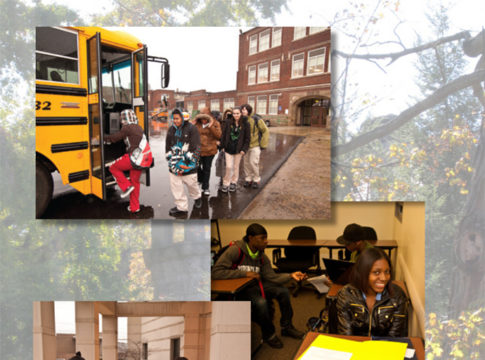EDUCATION NEXT NEWS
FOR IMMEDIATE RELEASE
CONTACT:
Janice B. Riddell, (203) 912-8675, janice_riddell@hks.harvard.edu, External Relations, Education Next
June Kronholz, junekronholz@me.com (effective 5/20/11; please contact J. Riddell with immediate questions)
Through Dual Enrollment, High School Students Get an Early Start on College and Careers
Students have the chance to accelerate and gain workforce skills, but roadblocks to dual enrollment remain
CAMBRIDGE, MA – A new analysis of data from the Education Commission of the States (ECS) finds that almost every state has some type of dual-enrollment policy, which allows high school students who are ready for college work to enroll in college courses while completing their high school programs. Twelve states require their school districts and public postsecondary schools to develop dual-enrollment partnerships. The U.S. Department of Education reports that as of 2005, 98 percent of community colleges and 77 percent of public four-year colleges were participating in dual enrollment programs.
In “High Schoolers in College,” to be published in the Summer 2011 issue of Education Next, author June Kronholz points out that “dual enrollment promises to speed youngsters through college and into the workforce, cutting college costs for parents and taxpayers alike.” Among the roadblocks to the wider use of dual enrollment are seat-time and mandatory-attendance laws, which states passed a century ago, often under pressure from labor unions, to keep young people in school and out of the competition for jobs. Kronholz observes, “The laws haven’t changed much today, but kids have, and by their midteens, many of them — bored with high school or academically beyond it — are ready for the next step.”
Dual enrollment is one of the key means that states take to allow students who are academically advanced a way to obtain a level of academic challenge that many high schools do not provide. The 2009 National Assessment of Educational Progress shows that reading and math scores for the highest-achieving 10 percent of 8th and 12th graders have barely budged in the past five years, which is evidence, Kronholz notes, that many of the country’s brightest youngsters are “stuck in an academic rut.” One 18-year-old student she visited, who has taken several college courses in nursing through a dual enrollment program at Indiana University-Purdue University Indianapolis (IUPUI), said that in high school “I’m only learning in a few of my classes.” Another IUPUI student, who started taking college courses as a 14-year-old 8th grade home schooler, has completed an entire freshman-year college curriculum over the past four years, including all the math he’ll need toward an engineering degree. Across the nation, about 240,000 youngsters in grades 4 through 8 take part in university-sponsored talent searches each year and the demand for accelerated options is growing. Dual enrollment programs are not just for the academically advanced, however; over the past two decades they have become increasingly diversified, offering an array of opportunities for middle-of-the-pack students seeking a taste of college and students pursuing vocational training.
Funding — particularly who pays for college classes — is the stickiest issue in implementing dual enrollment programs. With state education budgets under pressure, many states haven’t provided money to pay high-school students’ tuition for college courses. A few states split their per-pupil funding between the high school and the sponsoring college; others place the cost on the school district, college, or state board of education; and in 22 states, it is up to students or their families to pay for college courses. Kronholz also notes that high schools aren’t always eager to see their brightest students opt out of AP classes for a dual-enrollment program, because “school ratings — and therefore, teacher bonuses — depend in part on how many AP classes they offer, how many kids enroll, and how well they score on the AP exam.” Other institutional barriers – such as some school districts’ policies prohibiting youngsters from leaving campus during the day – also impede implementation of dual enrollment programs.
About the Author
June Kronholz is a former Wall Street Journal foreign correspondent, bureau chief, and education reporter, and currently a contributing editor at Education Next.
About Education Next
Education Next is a scholarly journal published by the Hoover Institution that is committed to looking at hard facts about school reform. Other sponsoring institutions are the Harvard Program on Education Policy and Governance, part of the Taubman Center for State and Local Government at the Harvard Kennedy School, and the Thomas B. Fordham Foundation.
For more information please visit: www.educationnext.org



